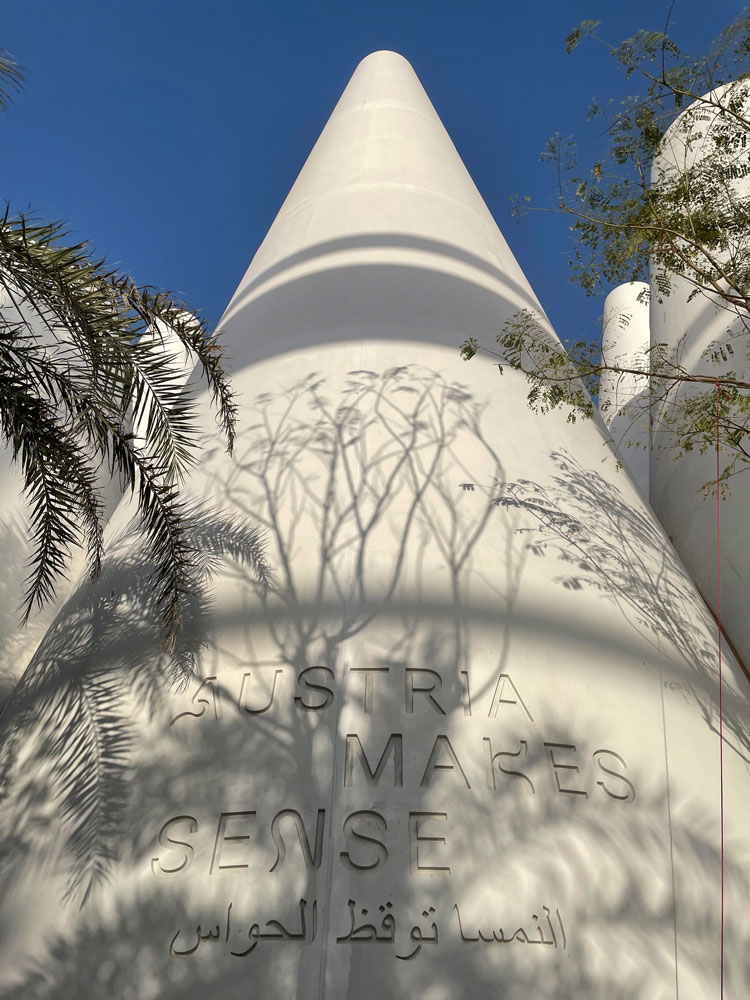February 2021
Text: Benjamin Berggold; Fotos: querkraft, Patricia Bagienski, bleed

From 1 October 2021 to 31 March 2022, Dubai, the largest city in the United Arab Emirates (UAE) will host a registered “major” World Expo – a year later than initially scheduled, due to COVID-19, but still under the name EXPO 2020. Austria will be one of about 180 nations that present themselves at the EXPO to an expected audience of 25 million attendees with a unique pavilion.
The Vienna-based architecture firm querkraft won the bid to construct the Austrian pavilion. We were picked by the Federal Ministry for Digital and Economic Affairs and by the Austrian Economic Chamber to develop and enact the theme of Austria’s participation. In this conversation, DI Gerd Erhartt (CEO of querkraft) gives us some insights into querkraft‘s work and the course of the project so far.
What are your major projects, apart from the 2020 EXPO? What were the greatest challenges? Which project are you particularly proud of?
A major leap in our evolution was the award of the bid for the ADIDAS Brandcenter in Herzogenaurach. The “Liaunig“ museum in Neuhaus near Lavamünd certainly is one of the most important projects for us. In several stages, Austria’s largest private art museum was created. Now, it is already listed as a protected landmark. Two projects that we are currently very invested in are the first downtown IKEA in Vienna, that comes without a single parking spot and can be reached with public transportation, and the EXPO pavilion in Dubai.
How did you experience the bidding procedure for the 2020 EXPO? How many competitors did you win against?
It was an international two-phase competition. In the first phase, we competed against 42 participants and in the second phase against eight. The competition called for the general planning of the architecture and the exhibition. The task was to develop an overall concept.
In your opinion, what are the features that set the 2020 EXPO pavilion apart?
It is the first time that an Arab country hosts an EXPO. For us, the context is always an important reference point. What sets the pavilion apart is that we paired technologies of traditional Arab architecture with Austrian high-tech engineering to create a contemporary design language. One element of Arab architecture is the so-called windcatcher (Badgir). Natural convection cools the houses. We translated these windcatchers into a system of cone-shaped buildings of different heights. Despite Dubai’s high air temperatures, the pavilion will maintain a pleasant temperature, with only moderate use of conventional air conditioning. This way, it will consume 70 % less energy than comparable conventionally climatized EXPO pavilions.
The pavilion has a well-thought-out floorplan and is divided into an open zone and a climate-controlled zone where the temperature is controlled, and energy saved via cooled subterranean airflow and the controlled opening and closing of doors and cone-type roofs. In the night time, the concrete and clay walls will absorb the cool air and cool down the rooms during the day. Plant-packed cone structures, an interior patio with dense greenery and misting systems will also contribute to a naturally controlled climate. In the pavilion, the unusual “living“ rooms will play with surprising room sequences and incidences of light, inspiring visitors to pause, observe and experience Austria with all their senses: the green, diverse landscape, the innovative business location, the food and hospitality, the high quality of life and the position as a mediator in the centre of Europe.
What significance does the EXPO pavilion have in terms of sustainability/indoor climate/construction material?
The pavilions need to be disassembled after the EXPO. The most sustainable solution is to use a building for the longest possible time. We therefore developed a modular pavilion that works like a Lego kit: It can be disassembled and re-assembled at a different location and adapted to its new use. We are currently discussing the subsequent use with different organisations. Using concrete for the shell construction proved to be the most suitable material, considering the various parameters (building physics, load-bearing capacity, durability, cost-effectiveness, licensability, and so on).
A pleasant indoor climate depends on a variety of factors besides temperature, such as air movement, light and shade, air humidity, people’s activity, expectations. All factors are taken into account.
In hindsight, what would you do differently regarding the planning and execution of the EXPO pavilion?
An EXPO is already a major challenge when it comes to planning and executing a project. You have to find your way around a different culture, in a different country within a very short period of time. The entire EXPO team, including the client, the project management and the planning team with all the consultants, has worked together in a very constructive and harmonic way, so there’s not really something that I’d wish to improve. In the competition, we approached the task mainly from an architectural perspective. We didn’t have a partner for the thematic enactment on board. büro wien joined us at a much later point in time, when we had already looked around for some time. Should we ever submit another entry in an EXPO bid, we’d look for a professional partner right from the start. A partner like, for example, büro wien.
How would you describe the cooperation with büro wien?
Apart from their expertise, we value in our partners the ability to think beyond the immediate task. This was particularly important in the case of this project. At an EXPO, nations compete for attention. For a country as small as Austria with a correspondingly tight budget, it is not easy to survive in this competition. All the more reason to commit to a clear concept. In the creation, elaboration and precise verbalization of the experience in the Austrian pavilion, büro wien was an instrumental driving force and discussion partner. Aside from that, having a solid network in the industry is a great asset. Without büro wien, the cooperation with Ars Electronica Solutions would not have been possible.





